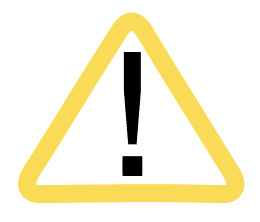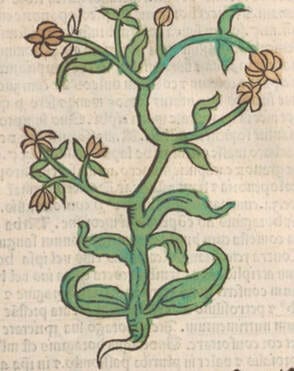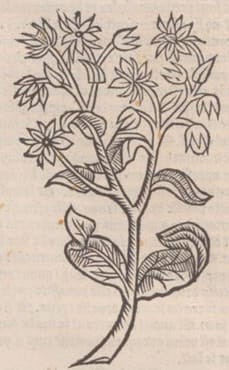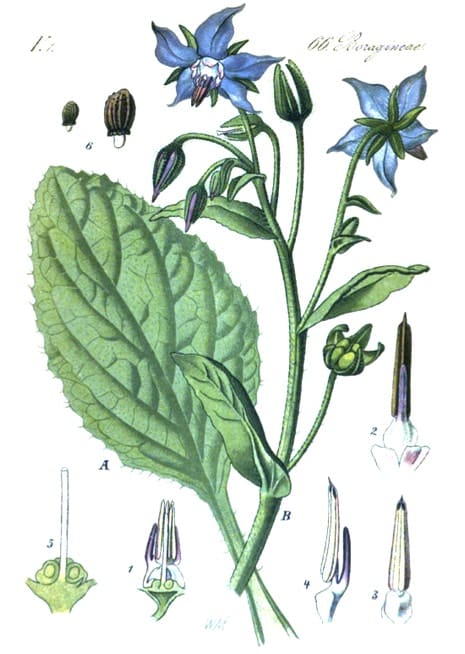Borago, BorageBoracheGaozaban (Unani |

|

|
 Herbarius latinus, Petri, 1485
Herbarius latinus, Petri, 1485 |
 Ortus Sanitatis, Cube, Johann von, 1501
Ortus Sanitatis, Cube, Johann von, 1501 |
 Flora von Deutschland (19), Kohler, 1884
Flora von Deutschland (19), Kohler, 1884Botanical name:
Borago officinalis
Parts used:
Root (bark removed); Leaf; Flower
Temperature & Taste:
Neutral (some said Warm), moist; Schroder said Warm and Moist in the 1st degree
“It is moderate in temperament slightly inclining towards hotness. Its moistness is in the last phase of the first degree. The dried form contains less moisture” (Avicenna)
Classifications:
2E LENITIVE. 2L. EMOLLIENT. 2O. ASTRINGENT.
3B. FEBRIFUGE & ANTIPYRETIC. 3C. ALEXIPHARMIC. 3K. EXPECTORANT
4a. CEPHALIC. 4e. STOMACHIC. 4f. SPLENETIC
TCM:
B. Clears Heat, Cools the Blood
Uses:
1. Strengthens the Heart, Nourishes Yin:
-One of the Four Cordial plants
-Heart fire, Insomnia, Agitation
-Palpitations, heart weakness
-defends the Heart in Fever
-a ‘Great strengthener of Nature’. (Culpeper)
-“good for treating Restlessness, Melancholic diseases and Palpitation”. (Avicenna)
2. Clears Melancholy:
–‘cleanses the Vital and Animal Spirits from the soot thereof, and is so good in all Melancholy diseases’. (Schroder)
–‘frees the Vital and Animal Spirits from Oppression’. (Salmon)
-cherishes the Heart and Spirit: pensiveness, sadness, grief, depression, anxiety
-Frenzy, Lunatics, Madness, Insanity
-“It is a mild purgative for Melancholy humours”. (Avicenna)
3. Nourishes Yin, Clears Heat:
-chronic illness, low grade Fever, dry mouth
-dryness with constipation
-Trembling, Shaking from heat and Yin deficiency
-engenders good Blood (Gerard)
4. Nourishes the Lungs, Stops Cough:
-Heat or dry type Cough, Bronchitis, Asthma
-Pneumonia, Pleurisy, Consumption
-“useful in cough and roughness of wind-pipe” (Avicenna)
5. Clears Heat, Promotes Urine:
-painful, dark or scanty urine
-Kidney pain from heat, Nephritis
-Jaundice and Rheumatism
6. Clears Heat, Resists Poison:
-heat-toxin Spotted Fevers in children
-venomous Bites and Stings; Snake, Scorpion, Rabid Dog bites
7. Promotes Milk:
-Increases Milk flow (leaf, seed)
8. Externally:
-juice applied to the eyelids, or the distilled water or infusion dropped in improves sight; dimness of sight.
-applied to heat and inflammation
-ashes used as a gargle in Honey water for sores or ulcers of the mouth
-topically for Itch, Ringworm, Eczema, Scabs, Sores, Ulcers
-steam wash improves the skin and removes wrinkles
-distilled Borage water applied on linen to Bee stings takes away pain.
BORAGE SEED OIL:
Used for Rheumatoid Arthritis, Eczema, Dermatitis, Neurodermatitis, PMS, and to prevent Heart disease and Strokes.
Dose:
Decoction of the Root and Leaf: 3–6 grams (10–20 grams fresh)
Tincture (1:2 in 25% alcohol): 2–5 mls.
Powder: 500mg–2 grams
Fluid Extract: 2–4 mls.
Borage Seed Oil: 3–5 mls. to 10 mls.
Correctives:
1. White Sandalwood
2. Chebulic Myrobalan
3. Sumac (Unani)
Substitutes:
1. Damask Rose
2. Lemon Balm
3. Chicory
4. Indian Valerian (Unani)
Main Combinations:
Borage & Fumitory
1. Fever:
i. Tertian, Conserve of Borage
ii. Terian, Borage water with Syrup of Sorrel juice (Herbarium Horstianum, 1630)
iii. Quartan Fever, Borage water with Syrup of Wormwood (Herbarium Horstianum, 1630)
2. Consumption and Hectic Fever: combine Borage with Cinnamon, Clove-gilliflower (Dianthus caryophyllatus), Saffron (as in Cordial Cinnamon Water)
3. Cool and cleanse the Blood, Borage with Fumitory. It is stronger if Dodder, Senna and Aniseed are added.
4. To make good Blood, fresh Borage is taken with fresh Bugloss (Arnold de Villa Nova)
5. Eruptive Fevers: Borage with Marshmallow, Mugwort, Motherwort
6. Cold and weak Heart: Borage with Rosemary, Rose, Citron peel, Nutmeg.
7. To Cool the Heart:
i. take Borage Water, 2 oz.
ii. Borage with Balm and Sandalwood
8. Palpitations from Heat, Borage with Armenian Earth (Avicenna)
9. Cough and harshness of the Lungs, decoct Borage with Bugloss, Hyssop, Balm, White Lily root, Orris, Elecampane, Licorice, Figs (Arnold de Villa Nova)
10. Trembling, Syrup of Borage juice strengthens and cures (Herbarium Horstianum, 1630)
11. Loss of speech following Stroke, Borage with Calendula as a decoction in Ale posset (or wine) (as in Decoction for Apoplexy)
12. Neurasthenia, Borage with Wormwood
13. Melancholy:
i. Borage with Balm
ii. Borage with Scolopendra, Dodder, Senna, Asparagus root, Fennel seed, Aniseed, Licorice; decoct in wine (Arnold de Villa Nova)
iii. Borage with Senna, Polypody, Ginger, Raisin, Violet, Rose, Rosemary (as in Decoction of Senna)
14. As an Exhilarant, Borage with Bugloss, Balm juice, Saffron, Cooling Pearl Powder (as in Exhilarative Syrup )
15. Skin diseases from Bile (Heat) and Melancholy Borage with Chicory, Endive, Hop, Fumitory, Yellow Myrobalan, Black Myrobalan, Raisin, Tamarind (as in Decoction of Fumitory of Mesue)
Major Formulas:
Common Decoction
Decoction of Fruit and Flowers
Decoction of Senna
Decoction for Apoplexy (Countess of Kent)
Decoction of Fumitory of Mesue
Cordial Decoction (French Pharmacopoeia)
Exhilarative Syrup (Laurent)
Syrup for Apoplexy of Arnold de Villa Nova
Water for Cancer
Powder to Cool the Heart
Cautions:
1. Caution as it contains pyrrolizidine alkaloids. Do not overdose and avoid long-term use.
2. Best avoided in Pregnancy and the very young. It was used to promote Breasl Milk but is probably best not used during Breastfeeding.
Toxicity:
In a review of toxic reactions to the pyrrolizidine-containing herbal medicines Comfrey, Coltsfoot and Borage, no adverse effects were noted from Borage. (see here)
Main Preparations used:
Waters of both Herb and Flower, Syrup of the threefold infusion of the Flowers, Syrup of the Leaf Juice, an Essence of the Juice (thickened and clarified), Conserve of the Flowers
1. DISTILLED WATER of BORAGE.
Used for all the above purposes, and dropped in for red and inflamed eyes. Cleanses the Blood, Strongly strengthens the Heart and Brain, takes away all Sadness, Griefs and Depression.
2. BORAGE WINE.
‘The leaves and flowers of Borage put into wine make men and women Glad and Merry, and drive away all Sadness, Dullness and Melancholy, as Dioscorides and Pliny affirm’ (Galen).
Another says ‘good for Melancholy people and pains of the Heart, making men Merry and curing Madness’.
Yet another classical text said it is beneficial for Palpitations. It also cools and cleanses the Blood. (Wirtzung)
3. SYRUP of BORAGE FLOWERS.
‘Comforts the Heart, Purges Melancholy, and quietens the Frantic or Lunatic person … the Flowers of Borrage made up with Sugar do all the aforesaid with greater force and effect’. (Gerard)
4. A COMPOUND SYRUP of BORAGE .
‘Syrup made of the juice of Borrage with Sugar, adding thereto powder of the Bone of a Stags Heart, is good against Swooning, the Cardiac Passion of the Heart, against Melancholy and the Falling Sickness’. (Gerard)
5. PULP of BORAGE ROOT.
Boil Borrage roots until soft, then beat them well in a Mortar, and pass through a seive; to this paste, add an equal part of Refined White Sugar, and mix or boil to the thickness of Marmalade.
A cordial, and very good for Sadness and Melancholy; also ‘of good use in Pestilental times and against Malign and Pestilental diseases. It is said to restore in Consumptions’. Dose: 1-2 oz. (Pharmacopoeia Batena)
6. The HEAVENLY CARDIAC.
Borage Water 4 oz.
White Sugar, refined 16 oz.
Boil almost to the consistency of a Syrup, then, while boiling, add 6 oz. of fresh Borage flowers freed from their black spots, and continue boiling until the flowers are crisp, then remove from the fire, and mix with it 16 Gold leaves in fine powder, and 24 grains of Ambergris.
‘A most elegant Cardiac, recreating the Vital and Animal Spirits, and is profitable against all affections arising from Atrabilis: In Hypochondriac Melancholy, it has no second. It is not only Cardiac, but it is good against Diseases of the Breast and Lungs, as Colds, Coughs, Asthmas, tickling Rheums, Wheezing, Hoarseness &c’. It may be liberally used. (Pharmacopoeia Batena)
Last updated 01/24
GENERAL / REVIEW
–A Review on the Phytochemistry, Ethnobotanical Uses and Pharmacology of Borago Species.
–The chemical composition, botanical characteristic and biological activities of Borago officinalis: a review.
–Pharmacological basis for the use of Borago officinalis in gastrointestinal, respiratory and cardiovascular disorders.
–Report: Comparison of qualitative, quantitative analysis and antioxidant potential between wild and cultivated Borago officinalis leaves from palestine.
–A systematic review and quality assessment of case reports of adverse events for borage (Borago officinalis), coltsfoot (Tussilago farfara) and comfrey (Symphytum officinale).
–Cancer Prevention and Health Benefices of Traditionally Consumed Borago officinalis Plants.
–[Pyrrolizidine alkaloids in medicinal plants of Boraginaceal: Borago officinalis L. and Pulmonaria officinalis L].
–[Studies on the mucopolysaccharides of Tussilago farfara L., Symphytum officinalis L., Borago officinalis L. and Viola tricolor L].
ANTI-INFLAMMATORY
–Review of Anti-Inflammatory Herbal Medicines.
–Phenolic Profile and Comparison of the Antioxidant, Anti-Ageing, Anti-Inflammatory, and Protective Activities of Borago officinalis Extracts on Skin Cells.
ANTIOXIDANT
–Report: Comparison of qualitative, quantitative analysis and antioxidant potential between wild and cultivated Borago officinalis leaves from palestine.
–Antioxidant evaluation for Urtica urens, Rumex cyprius and Borago officinalis edible wild plants in Palestine.
–Extraction of Antioxidants from Borage (Borago officinalis L.) Leaves-Optimization by Response Surface Method and Application in Oil-in-Water Emulsions.
–Phenolic Profile and Comparison of the Antioxidant, Anti-Ageing, Anti-Inflammatory, and Protective Activities of Borago officinalis Extracts on Skin Cells.
COVID:
–Effectiveness of Borage plus syrup on COVID-19 patients in intensive care units.
ANTI-ULCER:
–Protective Effects of Borago officinalis (Borago) on Cold Restraint Stress-Induced Gastric Ulcers in Rats: A Pilot Study.
HYPOGLYCEMIC
–Hypoglycemic Activity of Tilia americana, Borago officinalis, Chenopodium nuttalliae, and Piper sanctum on Wistar Rats.
HYPERTENSION
–An ethnobotanical study of medicinal plants administered for the treatment of hypertension.
ANTI-AGING:
–Phenolic Profile and Comparison of the Antioxidant, Anti-Ageing, Anti-Inflammatory, and Protective Activities of Borago officinalis Extracts on Skin Cells.
NEUROPROTECTIVE:
–Neuroprotective Profile of Edible Flowers of Borage (Borago officinalis L.) in Two Different Models: Caenorhabditis elegans and Neuro-2a Cells.
MEMORY
–Protective effects of Borago officinalis extract on amyloid beta-peptide(25-35)-induced memory impairment in male rats: a behavioral study.
ASTHMA
–Effect of Borago Officinalis Extract on Moderate Persistent Asthma: A Phase two Randomized, Double Blind, Placebo-Controlled Clinical Trial.
CANCER
–Cancer Prevention and Health Benefices of Traditionally Consumed Borago officinalis Plants.
